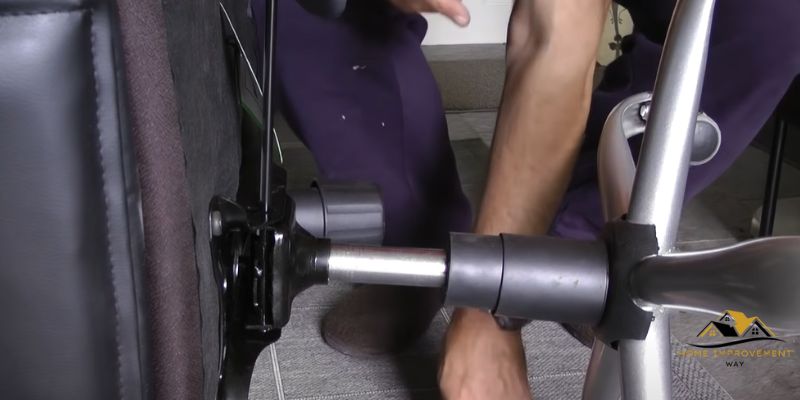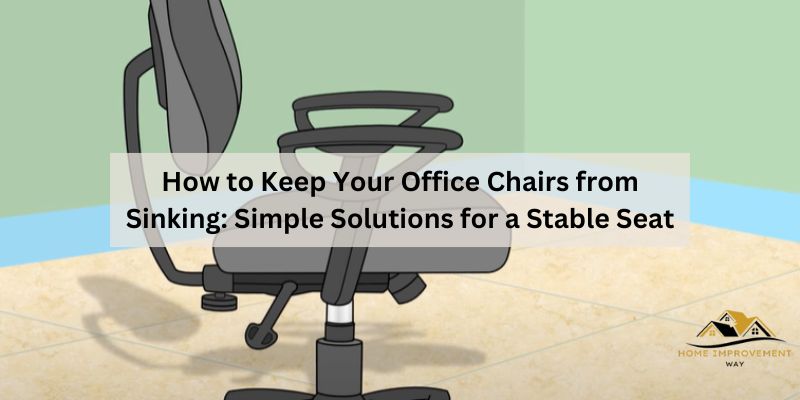To prevent your office chairs from sinking, you can adjust the chair’s height using the lever underneath the seat. Have you ever experienced the frustration of sitting in an office chair that slowly sinks down throughout the day?
It not only affects your posture and comfort but also creates a distracting and unprofessional atmosphere in the workplace. However, there is a simple solution to this problem. By adjusting the height of your office chair using the lever located underneath the seat, you can keep it from sinking and maintain a comfortable working position.
We will explore some effective tips to help you prevent your office chairs from sinking, ensuring a productive and ergonomic environment in your workplace.
Understanding The Problem
Learn how to prevent your office chairs from sinking with these easy tips and tricks. By understanding the problem and implementing the right solutions, you can ensure that your chairs remain at the right height, providing comfort and support throughout the workday.
Common Causes Of Sinking Office Chairs
In order to understand how to keep your office chairs from sinking, it is crucial to identify the common causes behind this frustrating problem. Often, the primary culprit is a faulty gas cylinder mechanism that loosens over time. A gas cylinder is responsible for adjusting the chair’s height, but when it becomes worn or damaged, it can cause the chair to sink unexpectedly. Another reason may be substandard construction or low-quality components used in the chair’s manufacturing process. Chairs that are unable to support the weight of the user typically show signs of sinking. Additionally, prolonged and excessive usage without proper maintenance can also contribute to the sinking of office chairs. Regular wear and tear, coupled with neglecting maintenance, can gradually deteriorate the chair’s internal components, leading to a sinking sensation when sitting on it.

Impact On Productivity And Comfort
The sinking of office chairs can greatly impact both productivity and comfort levels in the workplace. It might seem like a small inconvenience at first, but the repercussions are far-reaching. When a chair sinks repeatedly during the day, it disrupts the workflow and can hinder efficient task completion. Constantly readjusting the chair to the desired height not only takes valuable time away from work but also creates unnecessary distractions. Moreover, the discomfort caused by a sinking chair can lead to poor posture and prolonged periods of sitting in unhealthy positions. This, in turn, can result in physical discomfort, muscle fatigue, and even long-term health complications. A chair that doesn’t provide the necessary support and stability can also lead to decreased concentration, restlessness, and decreased productivity overall.
To prevent these issues, it is crucial to address the causes of sinking chairs and implement adequate solutions. Regular maintenance and timely repairs can help extend the lifespan of office chairs. Furthermore, investing in high-quality chairs crafted with durable materials and sturdy gas cylinder mechanisms can significantly reduce the likelihood of sinking. By understanding the problem and taking proactive measures, you can ensure a comfortable and productive work environment for yourself and your colleagues.
Preventative Measures
Preventing office chairs from sinking is essential for maintaining a comfortable and productive work environment. No one wants to constantly readjust their chair or feel like they are sinking into the abyss. By following these preventative measures, you can ensure that your office chairs stay in good condition and provide optimal support for years to come.
Choosing The Right Chair
Choosing the right chair is the first line of defense against sinking office chairs. When selecting a chair, consider the following:
- Quality: Opt for a chair made with high-quality materials and sturdy construction to ensure longevity.
- Adjustability: Look for a chair that offers height adjustment, lumbar support, and reclining features, allowing you to customize the chair to your comfort level.
- Weight capacity: Ensure that the chair you choose can support your weight and any additional equipment you may have.
Regular Maintenance And Inspections
Maintaining and inspecting your office chairs regularly can help identify potential issues before they lead to sinking. Follow these maintenance tips:
- Check screws and bolts: Regularly inspect and tighten screws and bolts to prevent loosening, which can contribute to sinking.
- Monitor gas cylinder: Pay attention to the gas cylinder that controls the chair’s height adjustment. If it shows signs of wear or leaking, consider replacing it.
- Inspect wheels: Ensure that the chair’s wheels are clean and in good condition. Replace any worn-out or damaged wheels promptly.
- Clean and lubricate: Regularly clean and lubricate moving parts, such as the recline and tilt mechanisms, to keep them operating smoothly.
Using Additional Support
In some cases, using additional support can help prevent office chairs from sinking. Consider these options:
- Chair mats: Place a chair mat with proper thickness and grip on the floor to provide stability and reduce pressure on the chair’s wheels.
- Cushions and pads: Utilize ergonomic cushions or memory foam pads for added support and to distribute weight evenly.
- Footrests: For individuals with shorter heights, using a footrest can help maintain proper posture and reduce pressure on the chair.
Repairing Sinking Office Chairs
Prevent sinking office chairs with these practical tips: adjust chair height properly, tighten hardware, replace gas cylinder if necessary, use floor mats, and invest in high-quality chairs designed for durability. Enjoy a comfortable and stable workspace without worrying about sinking chairs.
Office chairs are an essential part of any workspace, providing comfort and support throughout the workday. However, one frustrating issue that often arises is chairs that gradually sink, causing discomfort and affecting posture. If you’re dealing with sinking office chairs, don’t worry! In this section, we’ll guide you through the process of repairing and preventing this common problem. By following these simple steps, you can ensure your office chairs stay at the perfect height, providing maximum comfort and productivity.
Identifying The Cause Of Sinking
To effectively repair your sinking office chair, it’s crucial to identify the root cause of the issue. There are various reasons why a chair might start sinking over time. Here are a few common culprits:
- Worn-out gas cylinder: This is the most frequent cause of sinking chairs. The gas cylinder, responsible for controlling height adjustments, can deteriorate over time, resulting in gradual sinking.
- Loose height adjustment lever: A loose lever can cause the chair to slowly lower itself. Inspect the lever’s mechanism to determine if it needs tightening or replacement.
- Weakened mechanism: The internal components responsible for supporting the chair’s height may become worn or damaged, causing the chair to sink with use.

Adjusting Chair Height Mechanisms
Once you’ve determined the cause of the sinking, it’s time to take action. Before jumping into any repairs, make sure to adjust the chair’s height mechanisms properly. Here’s how:
- Start by sitting on the chair and placing your feet flat on the ground.
- Using your body weight, simultaneously lift the chair while pulling up on the height adjustment lever.
- Release the lever once the chair reaches your desired height.
Replacing Or Repairing Faulty Parts
If adjusting the chair height mechanisms doesn’t solve the sinking issue, it’s likely that faulty parts need to be replaced or repaired. Depending on the cause, you might need to replace the gas cylinder, tighten or replace the height adjustment lever, or repair the weakened mechanisms. It’s essential to refer to the chair’s manufacturer guidelines for specific instructions on replacing or repairing these parts.
Remember, each office chair is unique, and the repair process may vary. If you’re unsure about what steps to take, it’s always recommended to consult a professional or contact the chair manufacturer for assistance.
By correctly identifying the cause of sinking in your office chair, adjusting the height mechanism, and repairing or replacing faulty parts as necessary, you can keep your chairs in excellent condition and preserve optimal comfort and productivity in the office. Say goodbye to sinking chairs and hello to a more enjoyable and ergonomic work environment.
Conclusion
To prevent your office chairs from sinking, it’s crucial to understand the causes and implement effective solutions. By regularly checking chair components, adjusting height settings, and using chair mats, you can keep your chairs in excellent condition for a long time.
Remember to follow these simple tips to promote comfort and productivity in your workplace. Be proactive and prioritize the proper maintenance of your office chairs to avoid sinking issues.


